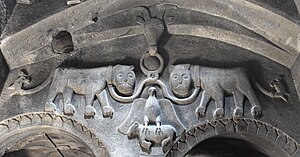| Proshyans Armenian: Պռոշյանք | |
|---|---|
| Armenian nobility | |
 | |
 Coat of arms of the Proshyans (one of the Coat of arms of Armenia), 1283, in Geghard, and approximate Proshyan territory within the Zakarid Principality of the Mongol Il-Khanate, circa 1300, in the Caucasus | |
| Country | Kingdom of Georgia |
| Founded | c. 1250 |
| Founder | Prosh Khaghbakian |
The Proshyan dynasty, also Khaghbakians or Xaghbakian-Proshians (Armenian: Խաղբակյանք/Պռոշյանք), was a family of the Armenian nobility, named after its founder Prince Prosh Khaghbakian. The dynasty was a vassal of Zakarid Armenia during the 13th–14th century CE, established as nakharar feudal lords as a reward for their military successes.[1] Zakarid Armenia was itself vassal of the Kingdom of Georgia from 1201, effectively falling under Mongol control after 1236, while Georgian rule only remained nominal. The Proshyans were princes of Bjni, Garni, Geghard and Noravank. The family prospered as an ally of the Mongols, following the Mongol invasions of Armenia and Georgia, as did the Zakarians and Orbelians.[2] Despite heavy Mongol taxes, they benefited from trade routes to China under the control of the Mongols, and built many magnificent churches and monasteries.[2]
- ^ Mathews, Thomas F .; Taylor, Alice (2001). THE ARMENIAN GOSPEL S OF GLADZOR THE LIFE OF CHRIST ILLUMINATED (PDF). The J. Paul Getty Museum Los Angeles. p. 22. ISBN 0892366265.
The Armenian brothers Ivane and Zak'are served the Georgian Queen Tamar (reigned 1184-1213). Rising to the heights of the Georgian army and court, they achieved for themselves the status of a nakharar family, called the Zak'arians, in honor of Zak'are. Queen T'amar gave the Zak'arians control of almost all her Armenian territories, including the former Armenian capital Ani. The Zak'arians established their own vassals, comprising both surviving nakharars and new men — from among their own Armenian generals — raised to nakharar status, each with smaller territories as their own fiefs. Among the new nakharars was the Proshian clan, who were particularly important for the history of the Gladzor Gospels.
- ^ a b Armenia: Art, Religion, and Trade in the Middle Ages - MetPublications - The Metropolitan Museum of Art. Metropolitan Museum of Art. 2018. p. 32.
The devastation caused by the Mongols is recorded in the colophons of many manuscripts of the period. Some Armenians, however, prospered as allies of, and soldiers and merchants for, the Mongols, including the Zakarian, Orbelian, and Proshian families. They continued or extended their existing trade routes into China, now controlled by the Mongols. Examples of Proshian success are seen at the church of the White Virgin (Spitakavor Astuatsatsin) with its relief carving of Amir Hasan (cat. 35) and in the exquisite, richly gilded reliquary presented by his father (cat. 36).
